Court Visit Report: Judge's Function in Criminal Case, Legal Methods
VerifiedAdded on 2021/03/22
|8
|2325
|255
Essay
AI Summary
This essay presents a court visit report from Blackfriars Crown Court, observing a criminal case and the roles of various court personnel. The report details the proceedings, the barristers' arguments, and the judge's actions, highlighting the courtroom dynamics. The essay also delves into the function of judges in the UK, examining their appointment process, historical evolution, and changes over time, including the establishment of the Judicial Appointments Commission. It discusses the evolution of the legal system, from the Anglo-Saxons to the modern judiciary, including the introduction of juries and the development of judicial independence. Furthermore, the essay addresses issues of ethnicity, gender, and class within the judiciary, providing statistics on the increasing diversity of judges. The author reflects on their experience, expressing a newfound interest in becoming a prosecutor after witnessing the proceedings and the confident presentation of the prosecution barrister. The essay concludes with observations on the importance of rational thinking in the legal field and the impact of the court visit on the author's career aspirations.
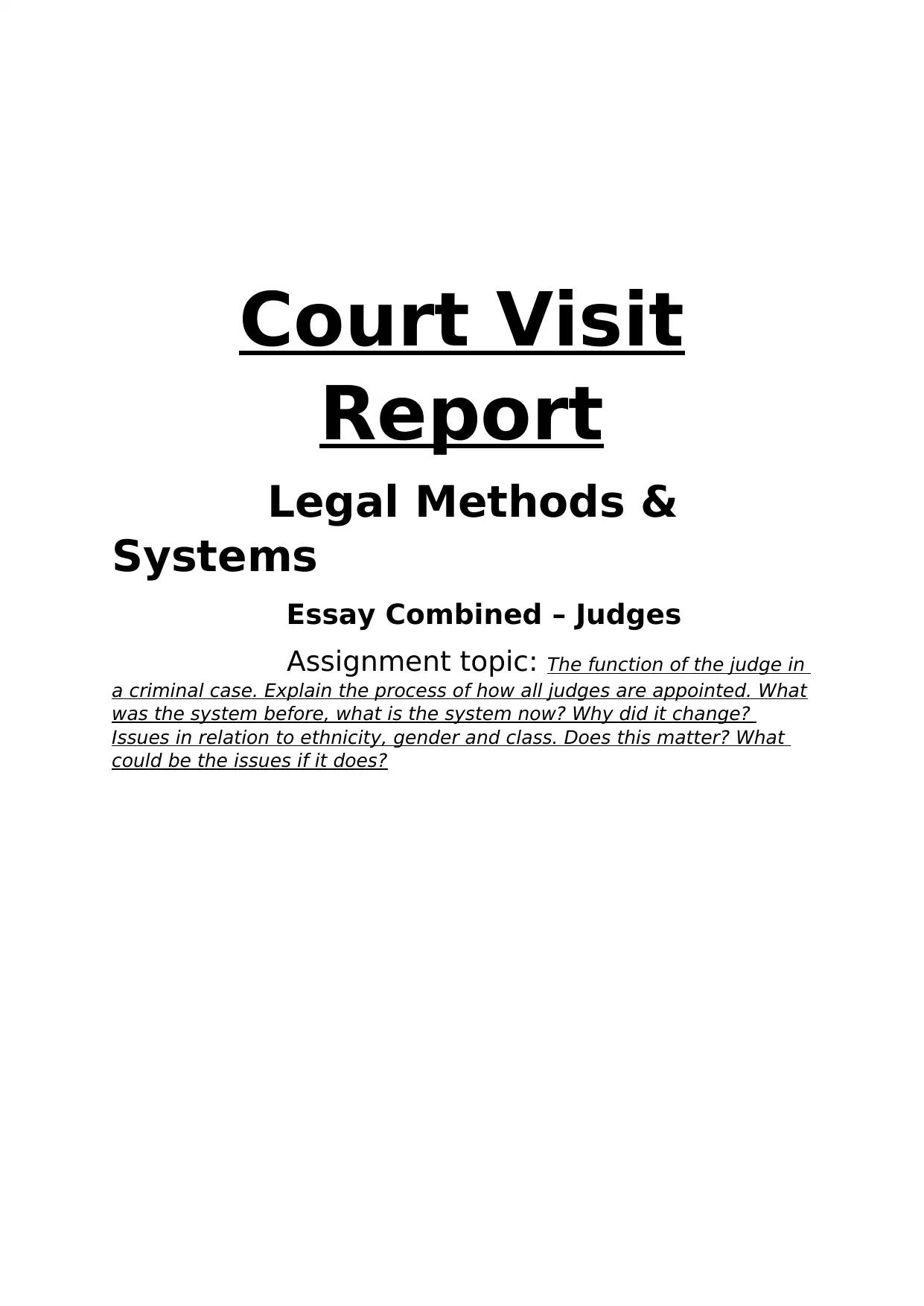
Court Visit
Report
Legal Methods &
Systems
Essay Combined – Judges
Assignment topic: The function of the judge in
a criminal case. Explain the process of how all judges are appointed. What
was the system before, what is the system now? Why did it change?
Issues in relation to ethnicity, gender and class. Does this matter? What
could be the issues if it does?
Report
Legal Methods &
Systems
Essay Combined – Judges
Assignment topic: The function of the judge in
a criminal case. Explain the process of how all judges are appointed. What
was the system before, what is the system now? Why did it change?
Issues in relation to ethnicity, gender and class. Does this matter? What
could be the issues if it does?
Paraphrase This Document
Need a fresh take? Get an instant paraphrase of this document with our AI Paraphraser
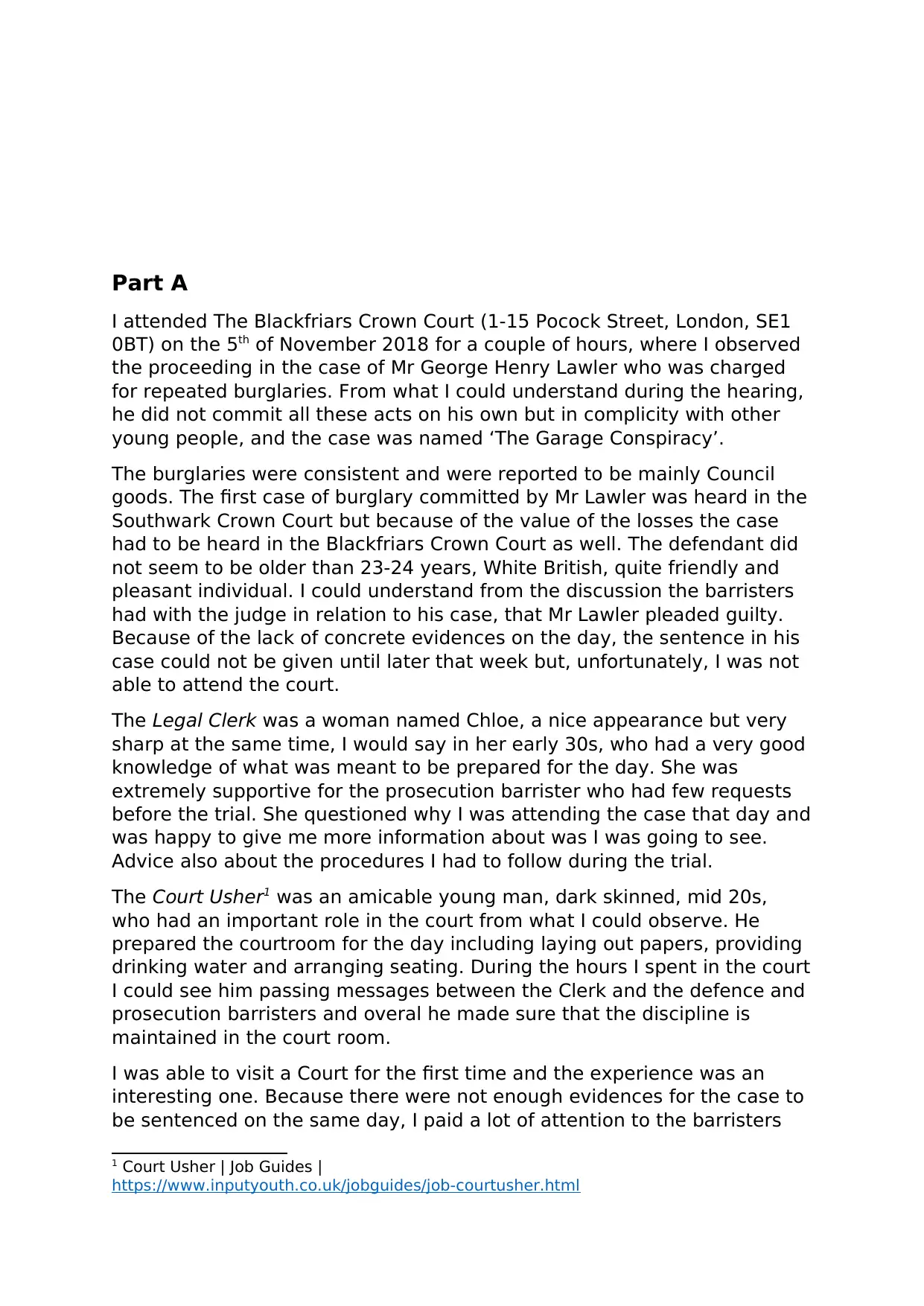
Part A
I attended The Blackfriars Crown Court (1-15 Pocock Street, London, SE1
0BT) on the 5th of November 2018 for a couple of hours, where I observed
the proceeding in the case of Mr George Henry Lawler who was charged
for repeated burglaries. From what I could understand during the hearing,
he did not commit all these acts on his own but in complicity with other
young people, and the case was named ‘The Garage Conspiracy’.
The burglaries were consistent and were reported to be mainly Council
goods. The first case of burglary committed by Mr Lawler was heard in the
Southwark Crown Court but because of the value of the losses the case
had to be heard in the Blackfriars Crown Court as well. The defendant did
not seem to be older than 23-24 years, White British, quite friendly and
pleasant individual. I could understand from the discussion the barristers
had with the judge in relation to his case, that Mr Lawler pleaded guilty.
Because of the lack of concrete evidences on the day, the sentence in his
case could not be given until later that week but, unfortunately, I was not
able to attend the court.
The Legal Clerk was a woman named Chloe, a nice appearance but very
sharp at the same time, I would say in her early 30s, who had a very good
knowledge of what was meant to be prepared for the day. She was
extremely supportive for the prosecution barrister who had few requests
before the trial. She questioned why I was attending the case that day and
was happy to give me more information about was I was going to see.
Advice also about the procedures I had to follow during the trial.
The Court Usher1 was an amicable young man, dark skinned, mid 20s,
who had an important role in the court from what I could observe. He
prepared the courtroom for the day including laying out papers, providing
drinking water and arranging seating. During the hours I spent in the court
I could see him passing messages between the Clerk and the defence and
prosecution barristers and overal he made sure that the discipline is
maintained in the court room.
I was able to visit a Court for the first time and the experience was an
interesting one. Because there were not enough evidences for the case to
be sentenced on the same day, I paid a lot of attention to the barristers
1 Court Usher | Job Guides |
https://www.inputyouth.co.uk/jobguides/job-courtusher.html
I attended The Blackfriars Crown Court (1-15 Pocock Street, London, SE1
0BT) on the 5th of November 2018 for a couple of hours, where I observed
the proceeding in the case of Mr George Henry Lawler who was charged
for repeated burglaries. From what I could understand during the hearing,
he did not commit all these acts on his own but in complicity with other
young people, and the case was named ‘The Garage Conspiracy’.
The burglaries were consistent and were reported to be mainly Council
goods. The first case of burglary committed by Mr Lawler was heard in the
Southwark Crown Court but because of the value of the losses the case
had to be heard in the Blackfriars Crown Court as well. The defendant did
not seem to be older than 23-24 years, White British, quite friendly and
pleasant individual. I could understand from the discussion the barristers
had with the judge in relation to his case, that Mr Lawler pleaded guilty.
Because of the lack of concrete evidences on the day, the sentence in his
case could not be given until later that week but, unfortunately, I was not
able to attend the court.
The Legal Clerk was a woman named Chloe, a nice appearance but very
sharp at the same time, I would say in her early 30s, who had a very good
knowledge of what was meant to be prepared for the day. She was
extremely supportive for the prosecution barrister who had few requests
before the trial. She questioned why I was attending the case that day and
was happy to give me more information about was I was going to see.
Advice also about the procedures I had to follow during the trial.
The Court Usher1 was an amicable young man, dark skinned, mid 20s,
who had an important role in the court from what I could observe. He
prepared the courtroom for the day including laying out papers, providing
drinking water and arranging seating. During the hours I spent in the court
I could see him passing messages between the Clerk and the defence and
prosecution barristers and overal he made sure that the discipline is
maintained in the court room.
I was able to visit a Court for the first time and the experience was an
interesting one. Because there were not enough evidences for the case to
be sentenced on the same day, I paid a lot of attention to the barristers
1 Court Usher | Job Guides |
https://www.inputyouth.co.uk/jobguides/job-courtusher.html
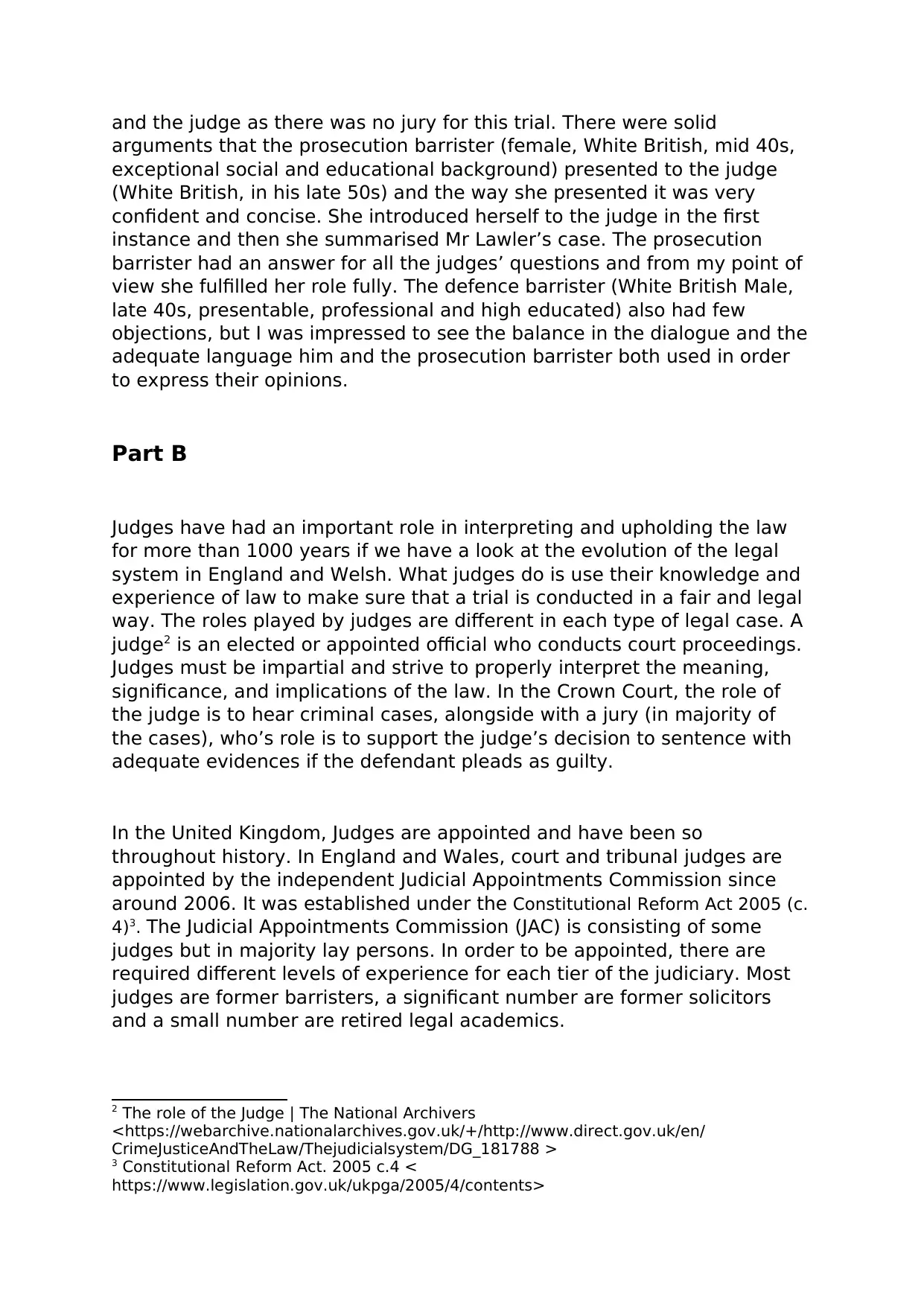
and the judge as there was no jury for this trial. There were solid
arguments that the prosecution barrister (female, White British, mid 40s,
exceptional social and educational background) presented to the judge
(White British, in his late 50s) and the way she presented it was very
confident and concise. She introduced herself to the judge in the first
instance and then she summarised Mr Lawler’s case. The prosecution
barrister had an answer for all the judges’ questions and from my point of
view she fulfilled her role fully. The defence barrister (White British Male,
late 40s, presentable, professional and high educated) also had few
objections, but I was impressed to see the balance in the dialogue and the
adequate language him and the prosecution barrister both used in order
to express their opinions.
Part B
Judges have had an important role in interpreting and upholding the law
for more than 1000 years if we have a look at the evolution of the legal
system in England and Welsh. What judges do is use their knowledge and
experience of law to make sure that a trial is conducted in a fair and legal
way. The roles played by judges are different in each type of legal case. A
judge2 is an elected or appointed official who conducts court proceedings.
Judges must be impartial and strive to properly interpret the meaning,
significance, and implications of the law. In the Crown Court, the role of
the judge is to hear criminal cases, alongside with a jury (in majority of
the cases), who’s role is to support the judge’s decision to sentence with
adequate evidences if the defendant pleads as guilty.
In the United Kingdom, Judges are appointed and have been so
throughout history. In England and Wales, court and tribunal judges are
appointed by the independent Judicial Appointments Commission since
around 2006. It was established under the Constitutional Reform Act 2005 (c.
4)3. The Judicial Appointments Commission (JAC) is consisting of some
judges but in majority lay persons. In order to be appointed, there are
required different levels of experience for each tier of the judiciary. Most
judges are former barristers, a significant number are former solicitors
and a small number are retired legal academics.
2 The role of the Judge | The National Archivers
<https://webarchive.nationalarchives.gov.uk/+/http://www.direct.gov.uk/en/
CrimeJusticeAndTheLaw/Thejudicialsystem/DG_181788 >
3 Constitutional Reform Act. 2005 c.4 <
https://www.legislation.gov.uk/ukpga/2005/4/contents>
arguments that the prosecution barrister (female, White British, mid 40s,
exceptional social and educational background) presented to the judge
(White British, in his late 50s) and the way she presented it was very
confident and concise. She introduced herself to the judge in the first
instance and then she summarised Mr Lawler’s case. The prosecution
barrister had an answer for all the judges’ questions and from my point of
view she fulfilled her role fully. The defence barrister (White British Male,
late 40s, presentable, professional and high educated) also had few
objections, but I was impressed to see the balance in the dialogue and the
adequate language him and the prosecution barrister both used in order
to express their opinions.
Part B
Judges have had an important role in interpreting and upholding the law
for more than 1000 years if we have a look at the evolution of the legal
system in England and Welsh. What judges do is use their knowledge and
experience of law to make sure that a trial is conducted in a fair and legal
way. The roles played by judges are different in each type of legal case. A
judge2 is an elected or appointed official who conducts court proceedings.
Judges must be impartial and strive to properly interpret the meaning,
significance, and implications of the law. In the Crown Court, the role of
the judge is to hear criminal cases, alongside with a jury (in majority of
the cases), who’s role is to support the judge’s decision to sentence with
adequate evidences if the defendant pleads as guilty.
In the United Kingdom, Judges are appointed and have been so
throughout history. In England and Wales, court and tribunal judges are
appointed by the independent Judicial Appointments Commission since
around 2006. It was established under the Constitutional Reform Act 2005 (c.
4)3. The Judicial Appointments Commission (JAC) is consisting of some
judges but in majority lay persons. In order to be appointed, there are
required different levels of experience for each tier of the judiciary. Most
judges are former barristers, a significant number are former solicitors
and a small number are retired legal academics.
2 The role of the Judge | The National Archivers
<https://webarchive.nationalarchives.gov.uk/+/http://www.direct.gov.uk/en/
CrimeJusticeAndTheLaw/Thejudicialsystem/DG_181788 >
3 Constitutional Reform Act. 2005 c.4 <
https://www.legislation.gov.uk/ukpga/2005/4/contents>
⊘ This is a preview!⊘
Do you want full access?
Subscribe today to unlock all pages.

Trusted by 1+ million students worldwide
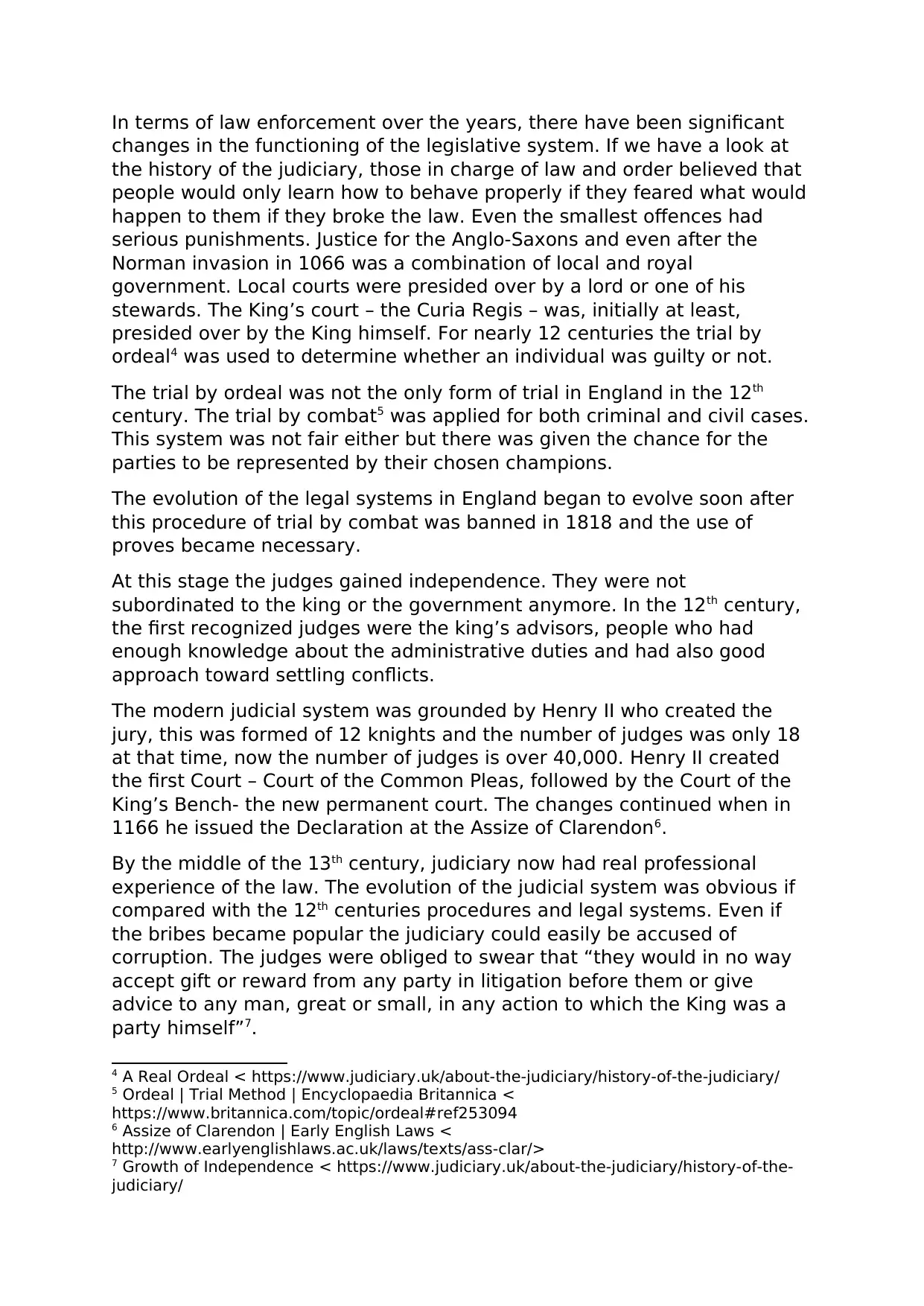
In terms of law enforcement over the years, there have been significant
changes in the functioning of the legislative system. If we have a look at
the history of the judiciary, those in charge of law and order believed that
people would only learn how to behave properly if they feared what would
happen to them if they broke the law. Even the smallest offences had
serious punishments. Justice for the Anglo-Saxons and even after the
Norman invasion in 1066 was a combination of local and royal
government. Local courts were presided over by a lord or one of his
stewards. The King’s court – the Curia Regis – was, initially at least,
presided over by the King himself. For nearly 12 centuries the trial by
ordeal4 was used to determine whether an individual was guilty or not.
The trial by ordeal was not the only form of trial in England in the 12th
century. The trial by combat5 was applied for both criminal and civil cases.
This system was not fair either but there was given the chance for the
parties to be represented by their chosen champions.
The evolution of the legal systems in England began to evolve soon after
this procedure of trial by combat was banned in 1818 and the use of
proves became necessary.
At this stage the judges gained independence. They were not
subordinated to the king or the government anymore. In the 12th century,
the first recognized judges were the king’s advisors, people who had
enough knowledge about the administrative duties and had also good
approach toward settling conflicts.
The modern judicial system was grounded by Henry II who created the
jury, this was formed of 12 knights and the number of judges was only 18
at that time, now the number of judges is over 40,000. Henry II created
the first Court – Court of the Common Pleas, followed by the Court of the
King’s Bench- the new permanent court. The changes continued when in
1166 he issued the Declaration at the Assize of Clarendon6.
By the middle of the 13th century, judiciary now had real professional
experience of the law. The evolution of the judicial system was obvious if
compared with the 12th centuries procedures and legal systems. Even if
the bribes became popular the judiciary could easily be accused of
corruption. The judges were obliged to swear that “they would in no way
accept gift or reward from any party in litigation before them or give
advice to any man, great or small, in any action to which the King was a
party himself”7.
4 A Real Ordeal < https://www.judiciary.uk/about-the-judiciary/history-of-the-judiciary/
5 Ordeal | Trial Method | Encyclopaedia Britannica <
https://www.britannica.com/topic/ordeal#ref253094
6 Assize of Clarendon | Early English Laws <
http://www.earlyenglishlaws.ac.uk/laws/texts/ass-clar/>
7 Growth of Independence < https://www.judiciary.uk/about-the-judiciary/history-of-the-
judiciary/
changes in the functioning of the legislative system. If we have a look at
the history of the judiciary, those in charge of law and order believed that
people would only learn how to behave properly if they feared what would
happen to them if they broke the law. Even the smallest offences had
serious punishments. Justice for the Anglo-Saxons and even after the
Norman invasion in 1066 was a combination of local and royal
government. Local courts were presided over by a lord or one of his
stewards. The King’s court – the Curia Regis – was, initially at least,
presided over by the King himself. For nearly 12 centuries the trial by
ordeal4 was used to determine whether an individual was guilty or not.
The trial by ordeal was not the only form of trial in England in the 12th
century. The trial by combat5 was applied for both criminal and civil cases.
This system was not fair either but there was given the chance for the
parties to be represented by their chosen champions.
The evolution of the legal systems in England began to evolve soon after
this procedure of trial by combat was banned in 1818 and the use of
proves became necessary.
At this stage the judges gained independence. They were not
subordinated to the king or the government anymore. In the 12th century,
the first recognized judges were the king’s advisors, people who had
enough knowledge about the administrative duties and had also good
approach toward settling conflicts.
The modern judicial system was grounded by Henry II who created the
jury, this was formed of 12 knights and the number of judges was only 18
at that time, now the number of judges is over 40,000. Henry II created
the first Court – Court of the Common Pleas, followed by the Court of the
King’s Bench- the new permanent court. The changes continued when in
1166 he issued the Declaration at the Assize of Clarendon6.
By the middle of the 13th century, judiciary now had real professional
experience of the law. The evolution of the judicial system was obvious if
compared with the 12th centuries procedures and legal systems. Even if
the bribes became popular the judiciary could easily be accused of
corruption. The judges were obliged to swear that “they would in no way
accept gift or reward from any party in litigation before them or give
advice to any man, great or small, in any action to which the King was a
party himself”7.
4 A Real Ordeal < https://www.judiciary.uk/about-the-judiciary/history-of-the-judiciary/
5 Ordeal | Trial Method | Encyclopaedia Britannica <
https://www.britannica.com/topic/ordeal#ref253094
6 Assize of Clarendon | Early English Laws <
http://www.earlyenglishlaws.ac.uk/laws/texts/ass-clar/>
7 Growth of Independence < https://www.judiciary.uk/about-the-judiciary/history-of-the-
judiciary/
Paraphrase This Document
Need a fresh take? Get an instant paraphrase of this document with our AI Paraphraser
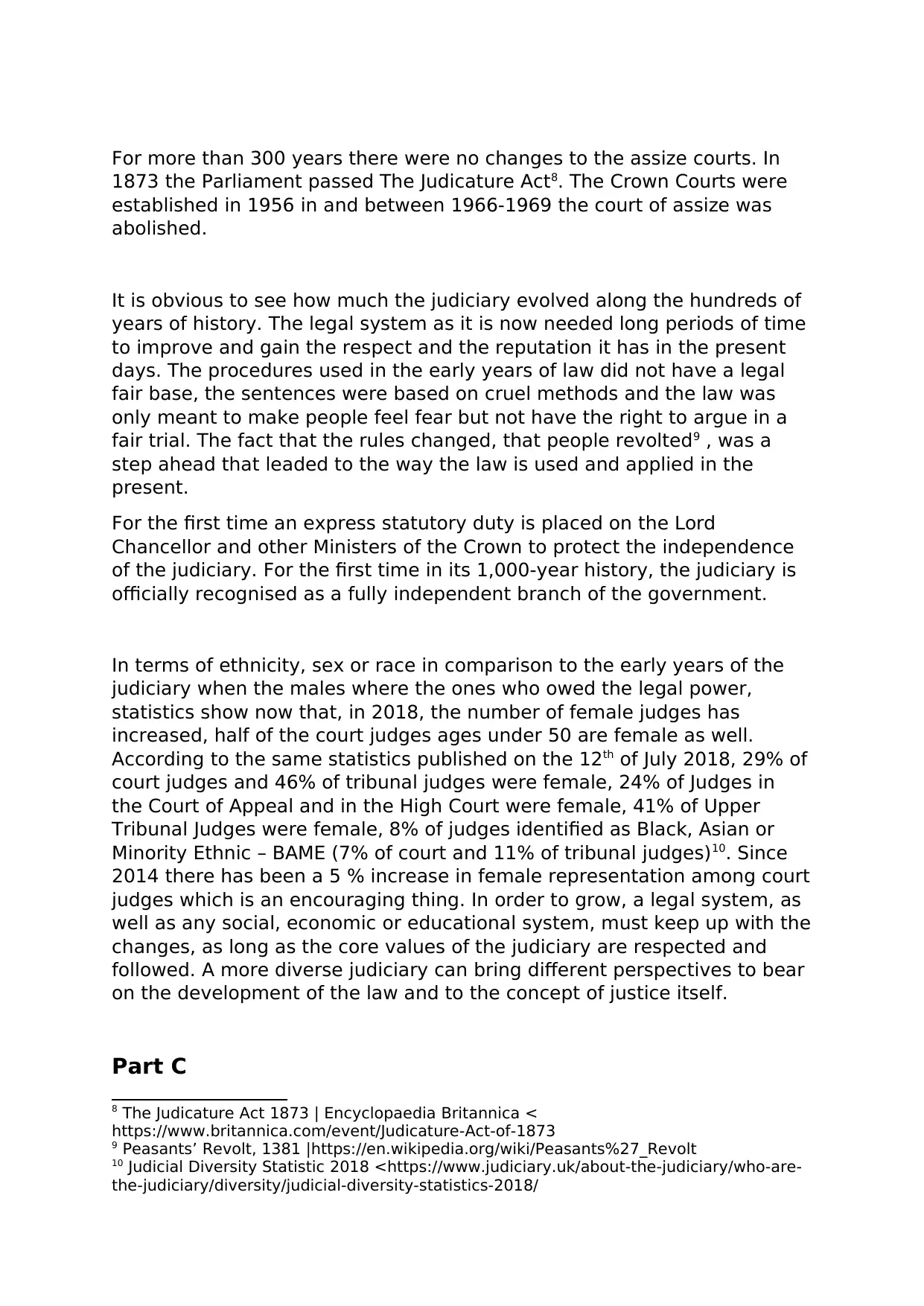
For more than 300 years there were no changes to the assize courts. In
1873 the Parliament passed The Judicature Act8. The Crown Courts were
established in 1956 in and between 1966-1969 the court of assize was
abolished.
It is obvious to see how much the judiciary evolved along the hundreds of
years of history. The legal system as it is now needed long periods of time
to improve and gain the respect and the reputation it has in the present
days. The procedures used in the early years of law did not have a legal
fair base, the sentences were based on cruel methods and the law was
only meant to make people feel fear but not have the right to argue in a
fair trial. The fact that the rules changed, that people revolted9 , was a
step ahead that leaded to the way the law is used and applied in the
present.
For the first time an express statutory duty is placed on the Lord
Chancellor and other Ministers of the Crown to protect the independence
of the judiciary. For the first time in its 1,000-year history, the judiciary is
officially recognised as a fully independent branch of the government.
In terms of ethnicity, sex or race in comparison to the early years of the
judiciary when the males where the ones who owed the legal power,
statistics show now that, in 2018, the number of female judges has
increased, half of the court judges ages under 50 are female as well.
According to the same statistics published on the 12th of July 2018, 29% of
court judges and 46% of tribunal judges were female, 24% of Judges in
the Court of Appeal and in the High Court were female, 41% of Upper
Tribunal Judges were female, 8% of judges identified as Black, Asian or
Minority Ethnic – BAME (7% of court and 11% of tribunal judges)10. Since
2014 there has been a 5 % increase in female representation among court
judges which is an encouraging thing. In order to grow, a legal system, as
well as any social, economic or educational system, must keep up with the
changes, as long as the core values of the judiciary are respected and
followed. A more diverse judiciary can bring different perspectives to bear
on the development of the law and to the concept of justice itself.
Part C
8 The Judicature Act 1873 | Encyclopaedia Britannica <
https://www.britannica.com/event/Judicature-Act-of-1873
9 Peasants’ Revolt, 1381 |https://en.wikipedia.org/wiki/Peasants%27_Revolt
10 Judicial Diversity Statistic 2018 <https://www.judiciary.uk/about-the-judiciary/who-are-
the-judiciary/diversity/judicial-diversity-statistics-2018/
1873 the Parliament passed The Judicature Act8. The Crown Courts were
established in 1956 in and between 1966-1969 the court of assize was
abolished.
It is obvious to see how much the judiciary evolved along the hundreds of
years of history. The legal system as it is now needed long periods of time
to improve and gain the respect and the reputation it has in the present
days. The procedures used in the early years of law did not have a legal
fair base, the sentences were based on cruel methods and the law was
only meant to make people feel fear but not have the right to argue in a
fair trial. The fact that the rules changed, that people revolted9 , was a
step ahead that leaded to the way the law is used and applied in the
present.
For the first time an express statutory duty is placed on the Lord
Chancellor and other Ministers of the Crown to protect the independence
of the judiciary. For the first time in its 1,000-year history, the judiciary is
officially recognised as a fully independent branch of the government.
In terms of ethnicity, sex or race in comparison to the early years of the
judiciary when the males where the ones who owed the legal power,
statistics show now that, in 2018, the number of female judges has
increased, half of the court judges ages under 50 are female as well.
According to the same statistics published on the 12th of July 2018, 29% of
court judges and 46% of tribunal judges were female, 24% of Judges in
the Court of Appeal and in the High Court were female, 41% of Upper
Tribunal Judges were female, 8% of judges identified as Black, Asian or
Minority Ethnic – BAME (7% of court and 11% of tribunal judges)10. Since
2014 there has been a 5 % increase in female representation among court
judges which is an encouraging thing. In order to grow, a legal system, as
well as any social, economic or educational system, must keep up with the
changes, as long as the core values of the judiciary are respected and
followed. A more diverse judiciary can bring different perspectives to bear
on the development of the law and to the concept of justice itself.
Part C
8 The Judicature Act 1873 | Encyclopaedia Britannica <
https://www.britannica.com/event/Judicature-Act-of-1873
9 Peasants’ Revolt, 1381 |https://en.wikipedia.org/wiki/Peasants%27_Revolt
10 Judicial Diversity Statistic 2018 <https://www.judiciary.uk/about-the-judiciary/who-are-
the-judiciary/diversity/judicial-diversity-statistics-2018/

I went to the Blackfriars Crown Court as a last-minute decision after
hearing a lot of opinions about the Old Bailey having very strict rules and
regulations. I did not want to have a bad first experience at a Crown
Court. However, being in the court, having the chance to observe the flow
of a trial in a criminal case, changed completely all my expectations. I was
impressed with everything I saw as it was a fascination environment.
I felt proud to go in and recommend myself as a law student and receive
the amazing feedback from the court representatives. I was invited to
take a seat in the public gallery area by the Court Usher from where I had
a clear view of all the aspects of the trial. I could see the judges’
appearance, attitude and tone of voice which matched the way I had it
portraited based on all the information I received in the lectures and
seminars. I must admit that I paid a lot of attention to the prosecution
barrister who managed her presentation speech in an impeccable way.
She approached the case in such a brilliant way, with a lot of confidence
and appropriate legal terms and this convinced me, even more than it did
when I enrolled in this course, that becoming a prosecutor would be the
most suitable career for me.
I did not know what to expect from the trial, but I realised that, in order to
have a clear vision of the circumstances it is always important to have a
rational and logical thinking rather than relying on emotions.
I was a bit disappointed that I did not get the chance to see the proper
trial, with concrete evidences and the sentence, however what I saw gave
me an idea about how the Legal Systems work in England. I will give
myself more opportunities to assist to more trials in order to analyse
better the legal system and procedures.
Bibliography
Primary sources:
Legislation
Constitutional Reform Act. 2005
Secondary sources:
Websites
1. Court Usher | Job Guides| https://www.inputyouth.co.uk/jobguides/job-
courtusher.html
2. The role of the Judge | The National Archivers
https://webarchive.nationalarchives.gov.uk/+/http://www.direct.gov.uk/en/
CrimeJusticeAndTheLaw/Thejudicialsystem/DG_181788
3. A Real Ordeal | https://www.judiciary.uk/about-the-judiciary/history-of-the-
judiciary/
hearing a lot of opinions about the Old Bailey having very strict rules and
regulations. I did not want to have a bad first experience at a Crown
Court. However, being in the court, having the chance to observe the flow
of a trial in a criminal case, changed completely all my expectations. I was
impressed with everything I saw as it was a fascination environment.
I felt proud to go in and recommend myself as a law student and receive
the amazing feedback from the court representatives. I was invited to
take a seat in the public gallery area by the Court Usher from where I had
a clear view of all the aspects of the trial. I could see the judges’
appearance, attitude and tone of voice which matched the way I had it
portraited based on all the information I received in the lectures and
seminars. I must admit that I paid a lot of attention to the prosecution
barrister who managed her presentation speech in an impeccable way.
She approached the case in such a brilliant way, with a lot of confidence
and appropriate legal terms and this convinced me, even more than it did
when I enrolled in this course, that becoming a prosecutor would be the
most suitable career for me.
I did not know what to expect from the trial, but I realised that, in order to
have a clear vision of the circumstances it is always important to have a
rational and logical thinking rather than relying on emotions.
I was a bit disappointed that I did not get the chance to see the proper
trial, with concrete evidences and the sentence, however what I saw gave
me an idea about how the Legal Systems work in England. I will give
myself more opportunities to assist to more trials in order to analyse
better the legal system and procedures.
Bibliography
Primary sources:
Legislation
Constitutional Reform Act. 2005
Secondary sources:
Websites
1. Court Usher | Job Guides| https://www.inputyouth.co.uk/jobguides/job-
courtusher.html
2. The role of the Judge | The National Archivers
https://webarchive.nationalarchives.gov.uk/+/http://www.direct.gov.uk/en/
CrimeJusticeAndTheLaw/Thejudicialsystem/DG_181788
3. A Real Ordeal | https://www.judiciary.uk/about-the-judiciary/history-of-the-
judiciary/
⊘ This is a preview!⊘
Do you want full access?
Subscribe today to unlock all pages.

Trusted by 1+ million students worldwide

4. Ordeal | Trial Method | Encyclopaedia Britannica |
https://www.britannica.com/topic/ordeal#ref253094
5. Assize of Clarendon | Early English Laws |
http://www.earlyenglishlaws.ac.uk/laws/texts/ass-clar
6. Growth of Independence | https://www.judiciary.uk/about-the-judiciary/history-of-
the-judiciary/
7. The Judicature Act 1873 | Encyclopaedia Britannica |
https://www.britannica.com/event/Judicature-Act-of-1873
8. Peasants’ Revolt, 1381 | https://en.wikipedia.org/wiki/Peasants%27_Revolt
9. Judicial Diversity Statistic 2018 |
https://www.judiciary.uk/about-the-judiciary/who-are-the-judiciary/diversity/
judicial-diversity-statistics-2018/
https://www.britannica.com/topic/ordeal#ref253094
5. Assize of Clarendon | Early English Laws |
http://www.earlyenglishlaws.ac.uk/laws/texts/ass-clar
6. Growth of Independence | https://www.judiciary.uk/about-the-judiciary/history-of-
the-judiciary/
7. The Judicature Act 1873 | Encyclopaedia Britannica |
https://www.britannica.com/event/Judicature-Act-of-1873
8. Peasants’ Revolt, 1381 | https://en.wikipedia.org/wiki/Peasants%27_Revolt
9. Judicial Diversity Statistic 2018 |
https://www.judiciary.uk/about-the-judiciary/who-are-the-judiciary/diversity/
judicial-diversity-statistics-2018/
Paraphrase This Document
Need a fresh take? Get an instant paraphrase of this document with our AI Paraphraser

1 out of 8
Related Documents
Your All-in-One AI-Powered Toolkit for Academic Success.
+13062052269
info@desklib.com
Available 24*7 on WhatsApp / Email
![[object Object]](/_next/static/media/star-bottom.7253800d.svg)
Unlock your academic potential
Copyright © 2020–2025 A2Z Services. All Rights Reserved. Developed and managed by ZUCOL.





